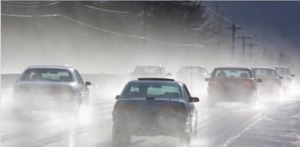Steve Wallace: Be prepared for driving in the wetter months ahead

Long, hotter summers with little precipitation make it doubly important to review the best way to drive in the rain.
Changing the windshield wipers at least twice a year on electric vehicles is a good idea. Most professional drivers will do this with every oil change or timed servicing. Detergent solutions should be used, as opposed to ordinary water, in the spray reservoir. Windshields get oily and need this solution applied.
Highway speed increases in the rain. This seems like a wild contradiction. One would think the reduced traction in rainy weather would cause most drivers to err on the side of caution and reduce speed. The opposite is true. The flapping of the wipers and the slapping of the tires has an excitement effect on drivers in rainy conditions. The rooster-tail spray of the back tires only adds to this effect.
Braking distance increases by as much as three times in the rain. Steering to avoid a crash becomes the preferred option by many experienced drivers, as opposed to the brake and hold.
Driving behind large transport trucks in the rain has its advantages. Despite the reduction in visibility, the water being cleared by the dual-tire combination can be a blessing to standard passenger-vehicle drivers. Traction increases and the visibility decrease are more than made up for by the leader of the pack clearing the roadway of pooling surface water.
In the absence of a big rig, it’s best to ride on the crown, as opposed to the depressed grooves created by traffic. A slight right-side lane position serves two purposes — it eliminates the possibility of hydroplaning, riding atop the slim film of water between the road and the tires, and is closer to the escape position on the shoulder of the road.
After a long period of drought-like conditions, the road will become very slippery in the first minutes of rainfall. The accumulation of grease and oil is only washed away after a significant deluge.
The only part of a vehicle that touches the road surface is the tread of the tires, so it’s of the utmost importance to have a good, deep, tread surface. Many people who drive for a living have a tire preference, whether it’s a sticky surface or one laced with walnut shells for increased traction.
It’s best to consult a tire expert selling a variety of recognizable brands. Knowing the type of vehicle, driving conditions and number of kilometres travelled will allow a tire professional to give the best advice.
Pooling water in tunnels and underpasses is a special hazard. The water colour often mimics the colour of the road surface. Extra caution must be exercised when choosing a route that includes traversing these kinds of depressions. Flooding can take place in a matter of minutes in low-lying areas.
Drivers caught in this predicament should open the vehicle windows immediately, allowing an avenue of escape if one is trapped in a rising pool of water.
Vehicles that are submerged with occupants still inside are subjected to tremendous outside pressure. In order to escape, it’s imperative that the people trapped inside have the self-discipline to allow the vehicle to fill with water, at least to the window level. This will equalize the pressure and make it easier to open the doors to expedite escape.
Every vehicle should be equipped with a side-window smashing device, which can be useful when vehicle doors are jammed. Most driving-safety kits include such a tool. They are available at several automotive retail outlets.
Rain, rain won’t go away. Prepare for it.
Steve Wallace is the owner of Joan Wallace Driving School on Vancouver Island. He is a former vice-president of the Driving Schools Association of the Americas, a registered B.C.
teacher and a University of Manitoba graduate.


